Modern Horizons Prerelease Primer
Modern Horizons is a wild, wild Magic set.
Mechanics from days long past! Slivers! Snow! Urza! Cards from all sorts of different Planes! It's a love letter to Magic.
And, of course, it's also the first-ever set to print cards directly into the Modern format.
Seeing this set evolve from its initial conception to finished product has been an incredible journey. And now you get to all experience it yourselves—at your local Prerelease!
But even if you've been to a lot of Prereleases before, a set like no other deserves a Prerelease like no other. (Spoiler alert: this time you can draft it!) A lot is different this time around, so let's take a look!
Finding the Horizons
Prereleases are my favorite Magic events of the year.
No matter where in the world I am or what time of year it is, I always try and go check out a local Prerelease. And I'm not alone: tons of Magic players, from seasoned veterans to folks just starting out, do the same! Prereleases are among the most popular events we throw.
Why? Because Prereleases are some of the most fun you can have playing Magic!
There's nothing quite like it. You get to sit down, pick up some brand-new cards, and figure out how you want to use them at the same time everybody else is. It's an even playing field in a casual environment, where everybody shares all that bubbling energy and excitement around a new Magic set!
I visited my first Prerelease when I was just eleven and instantly fell in love with the event. Eighteen years later, not too much has changed—and Prereleases are better than ever!
Prereleases are great because the set is totally new, the footing is fairly equal as everybody plays with the set for the very first time, and you're all just relaxing and having fun exploring the new cards. It's just a lot of fun for old and new players alike!
If you're a Prerelease veteran, you may want to skip ahead to the next section, where I talk about some of the differences you can expect at your local store for Modern Horizons. But if you're new to trying to find a store at which to play Prelease, let's cover that!
After all, you can't very well play if you don't know where to go. How might you go about that?
If you don't already have a local shop you frequent, be sure to check out the store locator to find one near you! That store may even offer preregistration. Prereleases are some of the most popular events we put on, so be sure to check and see if the store preregisters. The best time to find out an event is full is decidedly not when you show up and learn you can't play, so be sure to plan ahead.
Have you found your store? Excellent!
Now it's time to look ahead and prepare for the event. While you will be building your deck for the event with cards you receive there, there's plenty to do besides just that.
Be sure to pack all the supplies you will need for Modern Horizons! For example, you may still want to bring a Standard or Modern deck to play for fun between rounds, a trade binder, pen and paper to keep track of life, and even a water bottle.
A Prerelease event tends to take about 4–5 hours, so make sure to set aside enough time for the entire event. And you're going to need some fuel with all of that battling, so you may want to bring something like a protein bar or apple or Sliver jerky, or whatever else you like to snack on. (You may want to check with the store as well; they might even sell some food there!)
Okay now, let's see. You have a store selected on your map, and you've filled your pack with everything you'll need. Of course, you've taken a look at all the awesome cards in the Modern Horizons Card Image Gallery. Perhaps, if you were curious what a tournament might be like, you might have checked out my article conveniently titled "Your First Tournament."
You're all set! Now it's time to actually go and open up some of those cards!
Feeling a Draft
Modern Horizons does something pretty unique for a Prerelease: you can play either Sealed or Draft! (Talk to your store about which they'll be running—maybe it's both!)
Normally, Prereleases are all a format called Sealed Deck, where you're handed six booster packs, open them, and make a deck out of just those packs. This may be what you're used to.
Booster Draft, on the other hand, is a little different. But the good news is that it's pretty easy to get the hang of, and one of the most fun ways to play Magic—so let's learn!
I'll start by covering Sealed first.
In Sealed Deck, you're going to be handed six packs! They'll look like this:

You're going to open all of them up and build a 40-card deck out of them. You'll be able to add in as many basic lands as you need. (But not as many basic snow lands as you need—you'll have to use what you open to support your snow-matters cards!)
I'll get into how to deck build in a moment. But first, I want to explain how Draft works since it's a little more involved.
If you sign up for a Draft Prerelease, you're going to be handed three Modern Horizons boosters.
What you're about to do is a process where you end up with 45 Magic cards. Out of those cards, you will build a 40-card deck. (Keeping in mind, you'll want to add lands.) But you don't just open them and build out of them—you draft them!
You'll sit at a table with seven other people. Then, you'll open a booster pack! You'll look through all fifteen cards (Draft veterans: that snow land is draftable!) and choose one card to keep for your deck. Maybe because it's strong, maybe because you want to try and play that color, or otherwise. (Oh, and set aside that Modern Horizons Art Series card. That's yours to keep!)
Now here's the really unique part: you'll pass the remaining fourteen cards to the player on your left. Then you'll grab the cards that were just passed to you, select another card, and repeat!
You'll do this until all the cards in this first round of booster packs is gone. Then you'll repeat this by opening your second booster pack, except you pass to the right this time. Then, for the third pack, it's back to the left.
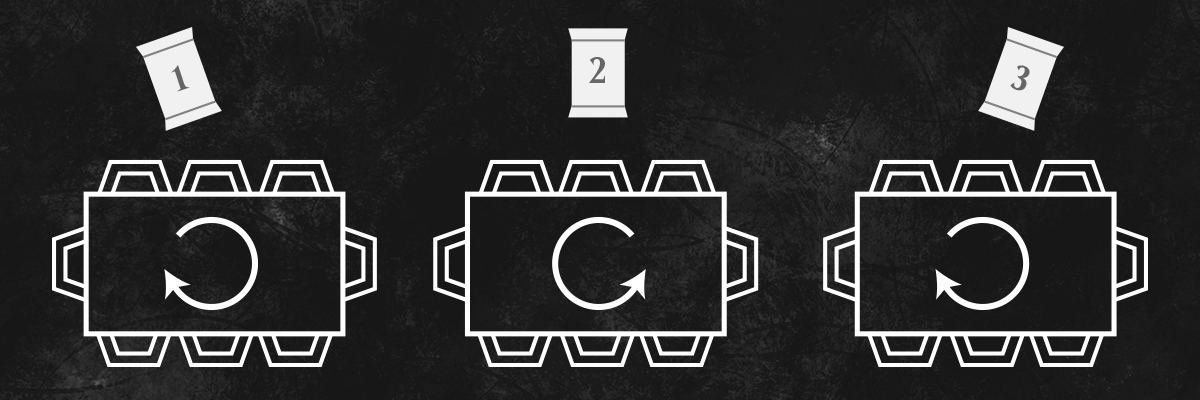
It's sort of like building your deck on the fly, and it's really fun! You never know just what is coming next, and your deck takes shape as you pick more cards.
Interested in more of the finer details of Booster Draft? You can check out the page explaining it here.
There's also a great article from Magic Pro League player Reid Duke that runs through the basics of Booster Draft. If you're newer to Draft, definitely go check that out here!
Whether you're playing Draft or Sealed, I recommend sticking to two colors or so. If you just pick some cards early in two different colors and stick with them, you should have a totally reasonable deck. You can sometimes "splash" for a third color, but, in general, you'll at least want to pick two to be your core.
Some things that may draw you into specific colors are:
- A really strong rare you're excited about;
- Plenty of "removal" cards that can deal with your opponent's creatures;
- A lot of playable cards in that color; or
- A good "mana curve" in that color—meaning lots of creatures of different costs.
Ideally, the colors you pick will meet all four of these goals, but if two or three are true, that's plenty good.
But then, of course, you need to narrow it down! How do you do that? Well, for one, if you get stuck at the Prerelease, feel free to ask the players around you for help. (You are allowed to do this at a Prerelease; everyone is there to make sure it's a fun event!)
But that aside, here's one process that may help!
First, lay your creatures out in mana-cost order. This helps you see what creatures you're going to potentially be able to cast at each part of the game. (Don't lay your noncreatures out at this point unless they're cards you are planning to play as soon as you have that much mana—for example, you will generally cast an Enduring Sliver on turn two, whereas Stirring Address isn't usually a turn-two play.)
A good "mana curve" of creatures is crucial to a successful Limited deck. ("Limited" is the umbrella term for the Booster Draft and Sealed Deck formats, as the pool of cards from which you can build your deck is limited to what you open during the event.) You don't want to have a ton of cards at any single spot in the curve. It's important for you to have a good mix so you can play your cheap spells in the early game and your expensive spells in the late game. As a very general rule for Limited, I would look to play something like this:
- 1 mana: 0–2
- 2 mana: 4–6
- 3 mana: 3–5
- 4 mana: 2–4
- 5 mana 1–3
- 6+ mana: 0–2
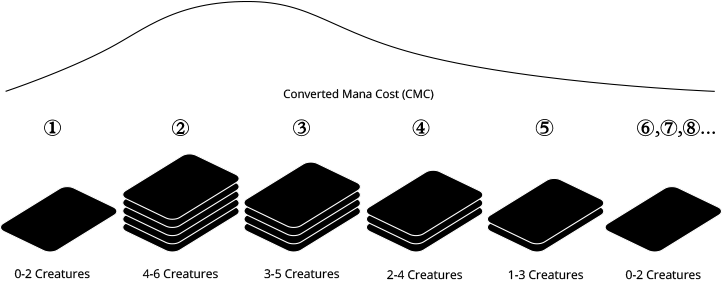
That's far from hard and fast, but it's a good place to start. Cull your creatures down to these numbers by choosing your favorites.
Now that you have your core creature base figured out, it's time to add in spells! Pick your favorites among your colors to bring your deck to 22 or 23 cards, and then you're good to go from the spell side.
The spells you're going to want the most are what are called "removal spells"—these are the spells that permanently neutralize your opponent's creatures by either dealing damage, keeping them tapped, or just straight-up destroying them. Limited Magic is all about creatures, so you'll want to play most of the cards in your colors that can get rid of your opponent's creatures.
If you want to learn more about mana curves, you can also check out my article on how to build a mana curve by clicking here.
Interested in more tips? Here are a few more things to keep in mind for deck building:
- You can play more than 40 cards, but you really should stick to 40 if possible. Every card you include past 40 just means it's that much less likely you're going to draw that awesome rare you put in your deck!
- The land ratio you're looking at should be about 17 lands to 23 nonlands. This isn't right 100% of the time, but most Limited decks end up looking like this, and, in general, it's what I would want to have.
- Play a mix of cheap-to-cast and expensive-to-cast cards. If you have all cheap, small creatures, then a single big creature can shut you down. If you have all large, expensive creatures, you risk getting run over first. Stick to a mix that focuses on the two-, three-, four-, and five-casting-cost creatures. More games of Sealed and Draft are won by casting a creature every turn starting on turn two or three than any other way.
- Evasion is important! Often, Limited games will get into stalls where both players have a lot of creatures and neither player can attack very well. Creatures with abilities like flying ensure that you can break through these creature stalls.
- Unlike most Magic formats, Sealed tends to be a little slower. If you are playing Sealed and your deck is on the slow side, choosing to draw (go second) rather than play (go first) can be reasonable to give you that extra card.
Finally, you'll also be handed a special, alternate-art version of Astral Drift! Oooh, shiny.
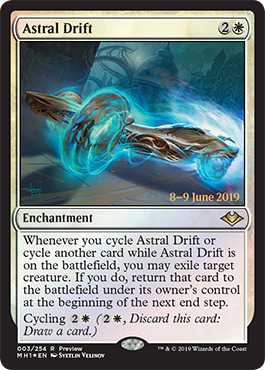
Unlike a randomized Prerelease promo, which you might be used to with other sets, this promo cannot go into your deck. So enjoy looking at it, take it in, hold it gingerly like you might hold a small child, but don't put it into your Limited deck. (Your cycling Commander deck, on the other hand
Two-Headed Giant
Some stores also support a version of Sealed Deck called Two-Headed Giant (often abbreviated "2HG"), where two players team up against other pairs of players. Each pair gets two Prerelease boxes from which the players build their decks. (If you've had a chance to try out the Battlebond set from last year, you may already be familiar!)
How does it work?
Well, the simple version is this: you and your teammate work together to build two 40-card decks. Then, you play against another pair of players in a one-game match.
How does this kind of multiplayer play out? It's simple: all your creatures and lands are separate, but you each share the same 30-point life total and take your turns simultaneously—plus you can block for each other too! To do the best you can, you'll need to work together to overcome the opposition.
This time around, because you can draft Modern Horizons, stores can also opt to run 2HG Draft events! You and your teammate will sit down and draft together using six packs, then build two decks to play with. It's a ton of fun.
Curious to learn more about how 2HG works and some of the intricacies of play? Be sure to check out the page all about it by clicking here. And be sure to contact your local store if you are interested in 2HG to see what they might be running!
Grab your Box
Trying to get the jump on your Modern decks, or just want to draft a bunch? Well, something relatively new to Prerelease is the ability to actually pick up a booster box!
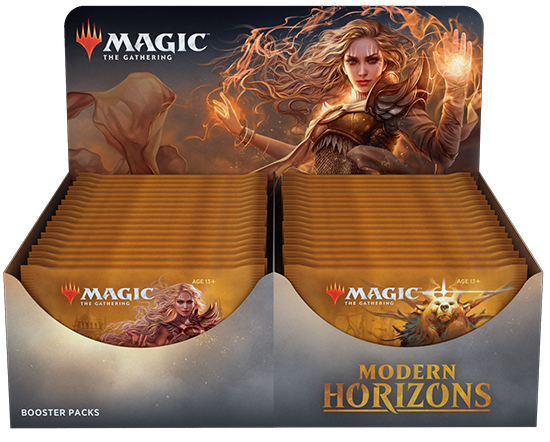
And of course, you'll get your buy-a box [autocard]Flusterstorm[/autocard] promo, too:
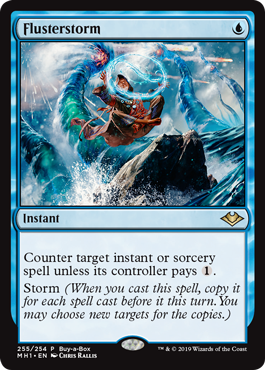
Pick up your box and bring it home (or crack it all open there!) on the day of the Prerelease! Contact your local store for more details.
Mechanical Horizons
There are a truly wild number of mechanics in Modern Horizons! With 40-plus mechanics running around, there's a lot to learn. Not to mention, all the snow and snow lands in every pack!
So if you're curious about how any of these work, check out the Modern Horizons mechanics glossary and the FAQ! Those should answer all the wonky-tonk questions these cards will no doubt cause.
A Fresh Perspective
This is one of the most exciting sets we've ever released. Between all the throwbacks, printing cards right into Modern, and tons of cards for your Commander decks to boot (not to mention a fun Limited format), this is a really wild time. Come be a part of it!
So, gather up your friends, take another look through the Card Image Gallery, make sure you're preregistered at your local store, and get ready to come have a blast at the Prerelease!
Wondering what to expect? Have any thoughts or questions? Feel free to send them my way. I'm happy to hear from you. You can always get in contact with me by sending me a tweet, messaging me on Instagram, emailing me, or asking a question on my Tumblr. I'll be reading them!
Have an amazing time—and enjoy Modern Horizons!
—Gavin
Email: BeyondBasicsMagic@gmail.com
Instagram: GavinVerhey
Tumblr: GavInsight
Twitter: @GavinVerhey

